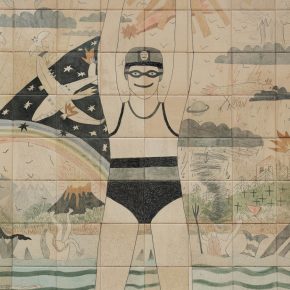Studio conversation with Louise Gibson
We caught up with Studio Holder Louise Gibson to hear about her materials and processes spanning recycled metal, resin labs and building relationships.
You work with resin, recycled metal, found fabric…
I have been working with resin for about twelve years now. I was self-taught initialy and then I had sponsorship for many years from a global resin manufacturer. I went into their labs and played around with their resins. The colour samples you can see here are all created through chemistry, using different additives, not with pigments. The additives are normally used to change the configuration of the resin for a particular type of product, but I’ve been using the additives as a way of finding colour and mixing colour, creating more organic tones by balancing these chemicals. I start with small samples, then scale up. I did a commission recently using about 300 kilos of resin.
I’m drawing up proposals for a new commission at the moment and also have these metal pieces in my studio that we made in the workshop. I tend to spend half the time down in the workshop and then half the time up here.
When did you come to ESW?
I’ve only been here for five months. This is the most civilized studio space I’ve ever had. Prior to being here, I’ve been in motorcycle garages and metal recycling yards. I’ve never been in a complex where you’ve got studios beside each other like this and I wasn’t sure if it was for me because I’ve always cohabited with businesses or trades, but this has been brilliant because you’ve got so much support. You’ve got lots of artists around you. It’s such a luxury to be so close to the workshops and it saves a lot of time.
Your work, on one hand, uses recycled and found objects, and, on the other hand, uses resin and chemicals. How do you make peace with these two contradictory worlds?
That’s what all the sculpture is doing in lots of different ways, you’re right, the materials are contradicting each other, and I am recycling as well as creating.
I worked with metal when I lived in Berlin and my studio was at a metal recycling business so I would choose things from the yard. It wasn’t about chosing valuable metals, I was choosing objects that have already had a previous, quite unsensational, lives. Sculpture with crushed washing machines, dishwashers, like these ones.
I also use a lot of fabrics that appear to be fluid and organic within the resin. I’m using the resin as a binder, to preserve them.
Would you say that industrial environment influenced you?
I think I really am drawn to industrial environments. I loved Berlin because it’s one of the messiest cities I’ve ever lived in. Everything is up for grabs and you’d walk down the street and there would be new stuff, whether that be from people moving out or from construction sites.
Your work looks like a scientific study on digestive system of industrial creatures and the recycled fabrics in resin look like they are under a microscope.
I have actually always been very interested in surgery. From quite a young age I collected anatomy books. Then when I got back from Berlin and needed a second job, I got into assisting in surgery and worked in trauma for about three years. I worked in plastics as well, which was really interesting to me because it’s reconstruction. I had this romantic vision of being able to think about ideas when I was there but, in reality, there is not a minute to think. But anything that you do as a creative person feeds back in to your practice. It’s all valuable.
These are two extreme, opposite worlds, the environment of a hospital and the one where I’ve seen you wearing extraordinary breathing equipment, looking like an alien, in a dirty garage, working on a huge piece of crushed metal.

It is so different. But to me it just makes sense. The hospital required me to be present, to communicate with people and I do that in my practice too, it’s about the processes involved and building relationships. I work with different trades; granite cutters, marble companies, car lacquer workshops. I am excited by other peoples’ interests and stories. It’s not just about the end product.
(later edit: Louise got the project!)
Studio conversation between Studio Holder Louise Gibson and Mihaela Coman on 9 February 2023.
More about her work here




